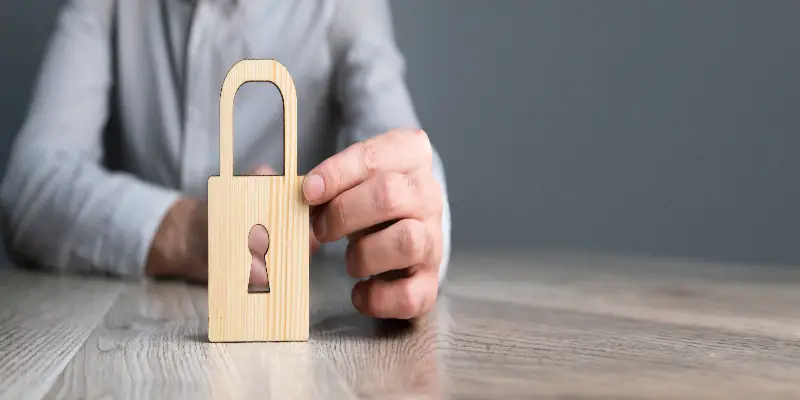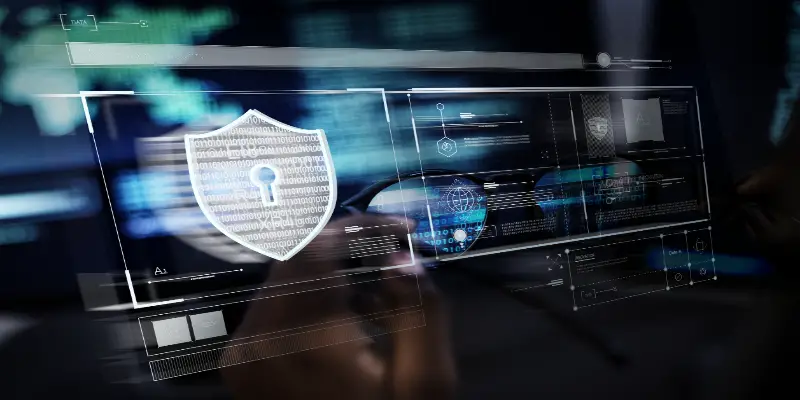Disclaimer: This post may contain affiliate links, meaning we get a small commission if you make a purchase through our links, at no cost to you. For more information, please visit our Disclaimer Page.
Nowadays, users need to keep all their information safe. Using passwords, encrypting data, and hiding folders are common things right now since everything is being shared on the internet.
Many software can be used to keep programs locked. Using password and data encryption would keep the information safe from any kind of malicious attack on the web. Putting passwords on programs is now available by using cybersecurity software and data encryption.
Today, I’ll talk about how to keep all the information secure in the computer, and what offers different software to protect programs against hackers and malicious attacks.
Table of Contents
Can You Password Protect a Program?
Yes, you can password protect a program by use of a third party software or manually if you have windows.
Review who can see what is saved in the computer, and which programs they can use, it is a priority. Passwords are codes generated by the user that allows conserving a program, document, folder, and file safeguard.
In the same order, a password that is complex and completely original gives the user more security to the programs locked by the password.
Typing an incorrect password would deny access to the protected program. There is a good deal of software that offers plenty of options to decide which type of password is the most accurate to the user’s needs.
A password provides a filter and control to have access to any kind of information and also can protect the programs from malicious software and hackers.
However, a user can suffer a password attack at any moment. A password attack is when someone tries to hack a password, to steal information from a device.
There are many ways that hackers can use to steal a password, from phishing to the use of keyloggers and malicious software.
There is always a possibility that someone tries to hack a password, but a stronger password would offer better defense to the programs.
It is always recommended to use a password with 8 – 10 characters and to mix capitalized letters, numbers, and symbols. The more complex, the better. The use of a complex and stronger password would stop hackers’ attempts.
Types of Password Attacks And How to Avoid Them
A password attack can happen at any moment. Since it is almost impossible to determine when this can happen, a user can always use some prevention methods or techniques to avoid this.
Use a stronger and complex password. As it was said before, this would stop any hacker attempts to access a device. But a hacker does not always try to guess a password.
There are many methods that can be used to steal a password, these are the most common and how to prevent them:
Brute Force Attack
A brute force attack is when a hacker uses different methods to constantly guess a password. The hacker can also use a system to force the entrance to the locked program.
However, in these cases, a hacker would try to guess the password or use a master password rather than other methods. Create a strong and complex password would help prevent a brute force attack. It will increase the time spent for the hacker trying to break through. It will also demoralize them and make them move on.
Having a simple or easy to guess password will easily allow a hacker to guess it.
Another thing that’s helpful is to have an option that locks out the guesser for a period after a certain amount of incorrect passwords are entered.
Phishing
Phishing occurs when a hacker presents to the user as a trustworthy source to extract personal data. The hacker would communicate with the user via email or text message.
To avoid a situation like this, the user must verify the information. Nowadays, almost everything can be found on the internet and figuring out whether or not something is a scam is also available.
For example, if the email says that it is from a company, the user can type the “company’s name” on the internet and check the email account, if the email direction doesn’t match, it is a scam.
Malware And Keyloggers
Programs and malware are commonly used to obtain the user’s information. These are viruses that detect every time a user enters any kind of personal data; the virus will send a copy of this information to the hacker.
Since it is really hard to detect when this happens, I always keep the antivirus turned on to prevent the infiltration of any malicious software.
Dictionary Attack
Dictionary attacks are similar to brute force attacks. Both methods are based on guessing the password, but the primary difference is that Dictionary attacks use a list of passwords made up of credentials, data, and phrases extracted from previous attacks.
This information is listed as a dictionary. Avoid using simple and weak passwords, and famous quotes as passwords.
Offline Hacking
Not all hackers steal information from the internet. Just like in the movies where hackers connect external devices to a computer, it is how offline hacking happens.
Control who has access to the room where the device is and avoids offline hacking.
How to Put Passwords on Programs?
To put passwords on programs, another program can be used. A password provides an initial defense, and there is a number of software that offers different protection to programs, including password protection.
Every software offers a set of options so the user can decide which one fits its needs. Many of these software often encrypt the information, and some of them offer double-step verification. However, there are different software for different systems.
There is not a “standard procedure” for all the systems, since every one of them works differently they might differ in some of the steps, and this is going to be explained down below.
Otherwise, if the user is looking to lock just a folder there is a way to set control and decide who has access to it.
On Windows, I can set up which user on the local web has access to a folder on my computer. The steps are very easy to follow, and there is no need to install the software. To lock a folder on Windows, I just select the folder and right-click on it.
Once the menu is open, I click on properties, then I go to the Security tab, press edit and I select who on the local web can have access. Those users who don’t have access will need an administrative password to enter the folder.
To set up an administrative password is very simple. Press Win + R, and on the tab type compmgmt.mcs and click enter.
Once the new is open, press on the User folder, then click on the Administrator account and select Set Password. And just like that, an administrative password has been set up.
How Do You Put a Password on a Program in Windows 7?
Windows do not have the option to set up a password without getting third parties. But this doesn’t mean that a program cannot be protected, as a user I only need to find suitable software that covers all my needs.
Free EXE Lock
Free EXE Lock is software that provides password security for exe files. Since Windows 7 is being left behind, it is hard to find software that is still available for this system.
However, Free EXE Lock runs on Windows 7 and offers to the user a set of features to keep a computer safe and locked.
The primary feature offered by this software is to block executable files. An executable file is the one that runs and starts a program, this file is seen by windows as the program itself, so once this is locked, no one can have access to the program.
Free EXE Lock also offers 2 optional encryption modes and a backup option in case something happens while encryption.
Password Door
Password Door offers protection directly on the program. While Free EXE Lock offers a password code to run an exe file, Password Door locks not only the exe file but all the files and complements to run a program.
This software is easy to use, with a friendly menu and different levels of protection for the programs.
Password Door has a free version and a pay one; and it is also available for Windows 2000, 2003, XP, 2008, Vista, 7, 8, and 10.
How Do You Put a Password on a Program in Windows 10?
Windows 10 offers encrypted protection for folders and files. As it was explained above, the user has to check the document properties menu and set up who has access.
This can be also done with the executive files; just like with folders, the user must right-click on the file and open the properties and go to the Security tab, and select the option to encrypt contents to secure data.
When some data is encrypted, the user would have a decryption key, this is a password that was set when the data encryption was done. Whoever has that password is going to have access to this data.
The aim of encrypting data is to protect it whenever this is open. When a folder or file in Windows is encrypted, an administrative password is set, and only administrator accounts can open with that password.
What Software Can You Use to Protect a Program?
Applications and programs must be often connected to the internet to work properly and be able to use all the features.
So to keep all the information safe I had to find a way to lock the programs, files, and folders on my computer.
Windows only offer support for files and folders in a local web, but whenever a user has synced its computer and programs with any Microsoft or Gmail account, it is vulnerable to hacker attacks from any part of the world.
Although, there are a few software programs that offer protection to the programs on my computer.
Program Protector
Program protector is one the most famous software for protecting programs on Windows. It offers password protection for any program that is installed on the computer.
The user can set a password and see who has tried to enter the programs, it is also easy to use and works on 32-bit and 64-bit systems.
My Lockbox
My lockbox hides, locks, and offers password support for any folder in the computer. It is very easy to use and has over 10 languages that can be displayed.
This software not only protects folders but locks any data. Users that acquire the free version can create one folder with an unlimited number of subfolders, and those who acquire the pay version can create many folders as they want.
Bitdefender Total Security
Bitdefender is software that provides support for any device. Bitdefender offers protection for any kind of data, and it has been named a pioneer in cybersecurity.
The software provides services for any kind of customer, it doesn’t matter if I am just a student or CEO, it offers thread prevention, malware detection, and data protection, anytime and anywhere.
Folder Guard
Folder Guard is security software that hides and locks files and folders. It restricts access to anyone who doesn’t have the password code. This software also offers support against any external device that tries to steal the protected information.
Gilisoft File Lock Pro
Gilisoft is a military-grade encryption tool available in several languages. This tool protects the files on the computer from any kind of malicious attack. Gilisoft offers support for Windows systems, macOS, and Android, and a free and paid version for each system.
Conclusion
Since everything is reflected and shared on the internet, users must keep their identities private. Users are constantly connected to the internet and synchronized with the rest of the world on the web.
Finding alternatives and keeping up with information is a need; learning and reading about how to maintain our personal information untouched is never a waste of time.



